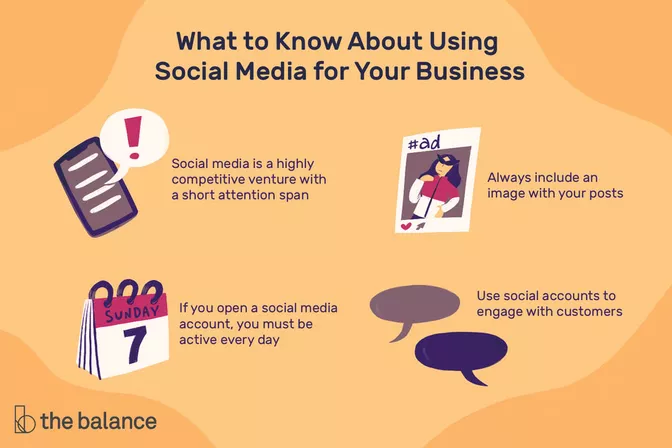:strip_icc():format(webp)/what-is-social-media-2890301-c13932bdde0e4c899e5c947d4d914218.jpg)
Social media refers to websites and applications that are designed to allow people to share content quickly, efficiently, and in real-time. While many people access social media through smartphone apps, this communication tool started with computers, and social media can refer to any internet communication tool that allows users to broadly share content and engage with the public.
The ability to share photos, opinions, and events in real-time has transformed the way we live and the way we do business. Here are the basics of understanding social media and how it can be used to help promote your business.
Contents
What Is Social Media?
Social media is any digital tool that allows users to quickly create and share content with the public. Social media encompasses a wide range of websites and apps. Some, like Twitter, specialize in sharing links and short written messages. Others, like Instagram and TikTok, are built to optimize the sharing of photos and videos.
What makes social media unique is that it is both broad and relatively uncensored. While many social media companies impose some limitations—such as taking down images that display violence or nudity—there are much fewer limitations on what someone can share than there with other means of mass communication like newspapers, radio stations, and television channels.
Anyone with internet access can sign up for a social media account. They can use that account to share whatever content they choose to, and the content they share reaches anyone who visits their page or profile.
How Social Media Works
Since social media covers so many different kinds of websites and applications, the function of these tools also varies. However, most social media sites start with a user creating a profile, usually by providing a name and an email address.
Once a profile has been created, users can create and share content. For instance, an Instagram user with a new account can take a picture and share it on their profile with a caption. In addition to creating content for their profile, social media users can find other users whose content they want to follow or comment on. Depending on the type of social media, a user may “follow” another user, add them as a “friend,” or they may “subscribe” to another user’s page.
Social media often uses “feeds” that allow users to scroll through content. Social media companies use algorithms, based on a user’s profile data, to determine the content that appears and the order that it appears in. The feed will include content from “followed” users, as well as from entities that pay to promote their content.
Types of Social Media
There are many different types of social media, and many services could fit into multiple categories. Here are a few of the major types, along with some examples.
Social Networks
Social networks specialize in connecting and exchanging thoughts, ideas, and content with other users—often with users who share tastes and interests. Facebook and Twitter are examples of social networks. Though more professional than others, LinkedIn may be considered a social network, as well.
Media Networks
As opposed to social networks, which specialize in letting users share and exchange raw thoughts and ideas, media networks specialize in distributing content like photographs and videos. Instagram and YouTube are examples of this. A YouTube user, for example, will upload a video they’ve created, and other users can “like,” “dislike,” or comment on the video. If they enjoy the video enough, a user may choose to “subscribe” to the creator, so that new videos from that creator appear in their feed.
Discussion Networks
Discussion networks like Reddit are the ideal outlet for posts that can spark in-depth discussion among users. Users can leave detailed responses in the comment section, and other users can respond directly to those comments, allowing for conversations to grow and develop organically.
Review Networks
Review networks like Yelp and TripAdvisor add social media aspects to user reviews of products and services. Users can interact directly with those leaving reviews, as can the businesses being reviewed.
Businesses and Social Media
While any individual can sign up for social media, social media platforms have become an important part of marketing for businesses of all sizes. The key to successful social media is to not treat it like an extra appendage but to treat it with the same care, respect, and attention you do all of your marketing efforts. Here are some things businesses should keep in mind while using social media.
Social Media Marketing Is Fleeting
By its nature, social media is a short attention span media—you have to catch their attention as they’re quickly scrolling through dozens of posts at a time. Ad headlines and copy are harder to fit into an attention-grabbing tweet than a traditional newspaper ad.
You Must Be Active on Social Media
One of the biggest mistakes retailers make is to open up accounts on every social media platform they think is relevant and then leave them alone with no activity. In fact, social media users may be turned off by the retailer who opens accounts and does not engage with clients or the public.
Focus on the Customer
Another big mistake retailers make is to use social media to talk about what is important to them rather than talking about what is important to the customer. Retailers who use social media, for instance, may think it is great to spread the word about a sale. In some ways, this would be true, but if that’s the only reason you are getting involved in social media, it won’t be beneficial. Your goal should be to provide content that is relevant to your customer and engage with them to the point that they want to share your post with others.
If you use social media, you need to engage with your customers, involve them in a dialogue, and ask them for their opinions. Post a picture of two items you are considering carrying in your store and ask customers which one they like best. This creates a dialogue that leads to shared posts and engaged followers. Plus, if you successfully engage with your customers, it will help you better identify their tastes and preferences.
Images Are Key
Another thing to consider is that the most commonly-shared content on social media is an image, so it’s a good idea to include an image with your posts.1 This will dramatically increase your chances that one of your followers will share the post with their network. While building up a large network of followers is great, a better measure of social media success is how often your followers share your content—no matter how many followers you have. This is the new form of “word of mouth.”
[“source=thebalancesmb”]




